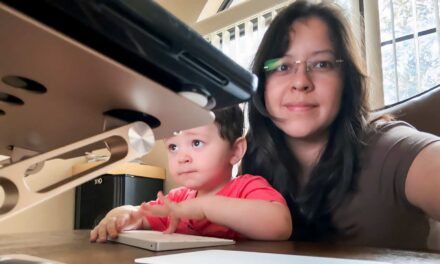
Tutor evolution: A new path for learning at scale
ASU professor's interactive tutorial program is helping students grasp the basics in introductory circuit classes

Above: Arizona State University Professor Brian Skromme (right) created Circuit Tutor as an interactive tutorial program that creates its own problems, circuit diagrams and solutions "on the fly". No two students ever receive the same problems to work, providing an unlimited source of problems and example solutions. Photographer: Erika Gronek/ASU
Brian Skromme believes that if he could individually tutor every student in his class, they’d all excel at the course material.
Since that isn’t the most practical method of teaching, Skromme — a professor of electrical engineering in the Ira A. Fulton Schools of Engineering at Arizona State University — decided to enlist the help of computers to create Circuit Tutor.
Circuit Tutor is an interactive tutorial program to guide students taking an introductory circuit class in a scalable way.
The tutorial program is currently used in circuit classes at ASU, Morgan State University, the University of Texas at El Paso, the combined engineering school at Florida A&M University and Florida State University, Messiah College and several community colleges. Its development and deployment are funded by a $1.25 million grant from the National Science Foundation.
“The tool first began to be used in fall 2012 and more extensively in spring 2013,” says Skromme, previously the assistant dean for academic and student affairs in the Fulton Schools. “It has expanded from only three tutorials at that time to around 23 tutorials today with more being added regularly.”
Circuit Tutor is a step-based tutoring system presented in a game-like format. Students get immediate feedback on every step of their work to avoid the frustration of working a problem through completely only to find it is wrong due to an error in the first step.
The system features a detailed set of problems that are created randomly, mirroring the type and difficulty of the ones students encounter in class.
“It is generally used as a substitute for all or part of the students’ homework,” says Skromme. “One of the unique features is that the system creates its own problems and circuit diagrams and solutions ‘on the fly,’ so that no two students ever receive same problems to work, and it can provide a fully unlimited source of problems and example solutions.”
What’s more, there are no solution manuals where students can simply get the answers without understanding the process it takes to get there. Instead, students are graded on their completion of the assignments and not penalized for mistakes or the number of attempts.
Skromme and his team have conducted several controlled, randomized, blind studies that measure students’ scores on post-tests. The results show students learn more effectively using Circuit Tutor than when they are doing paper homework or using a commercial, publisher-based system.
Because the tool uniquely accepts and checks every step of a student’s work and provides immediate, detailed feedback, the student can recognize mistakes early in the work, minimizing frustrations as they learn concepts.
“Students have also expressed strong preferences for the Circuit Tutor over alternative approaches and systems,” says Skromme. “We plan to try introducing some innovative features into the system, such as the ‘desirable learning difficulties’ that some researchers believe help greatly improve retention.”
The team hasn’t systematically analyzed grades or student retention yet in the courses where they’ve implemented the tool, but it is something they intend to explore as the system evolves.
“We are working to extend the topical coverage to all of the major course topics over the next couple of years so that it can fully support the course and some related ones,” says Skromme. “As it reaches maturity, we would like to disseminate use of the tool to many different colleges and universities across the country and even internationally.”
The Circuit Tutor system itself is limited to linear circuit analysis. However, the general approach of random problem generation coupled with step-based tutoring can potentially be used in a number of other introductory-level engineering courses.
“We are working with publishing company Wiley to develop a commercial version for wide dissemination, though it will also be available on a free basis to students,” says Skromme. “We would also like to explore using this system in some existing open online courses in this area.”


































